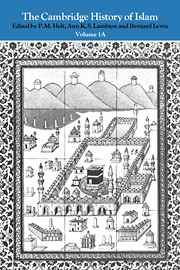Book contents
- Frontmatter
- Introduction
- Part I The rise and domination of the Arabs
- Part II The coming of the steppe peoples
- Part III The central Islamic lands in the Ottoman period
- 1 The rise of the Ottoman empire
- 2 The heyday and decline of the Ottoman empire
- 3 The later Ottoman empire in Rumelia and Anatolia
- 4 The later Ottoman empire in Egypt and the fertile crescent
- 5 Safavid Persia
- 6 Persia: the breakdown of society
- 7 Central Asia from the sixteenth century to the Russian conquests
- Appendix The Golden Horde and its successors
- 8 Tsarist Russia and the Muslims of central Asia
- References
3 - The later Ottoman empire in Rumelia and Anatolia
from Part III - The central Islamic lands in the Ottoman period
Published online by Cambridge University Press: 28 March 2008
- Frontmatter
- Introduction
- Part I The rise and domination of the Arabs
- Part II The coming of the steppe peoples
- Part III The central Islamic lands in the Ottoman period
- 1 The rise of the Ottoman empire
- 2 The heyday and decline of the Ottoman empire
- 3 The later Ottoman empire in Rumelia and Anatolia
- 4 The later Ottoman empire in Egypt and the fertile crescent
- 5 Safavid Persia
- 6 Persia: the breakdown of society
- 7 Central Asia from the sixteenth century to the Russian conquests
- Appendix The Golden Horde and its successors
- 8 Tsarist Russia and the Muslims of central Asia
- References
Summary
Ottoman ‘splendid isolation’ comes to an end
The treaty of Carlowitz (1110/1699) marks a turning-point in Ottoman history. The Ottoman empire, which had terrified Christendom for over three hundred years, ceased to be an aggressive power. From now on it mainly fought rearguard actions against the overwhelming might of Christian Europe. Yet it survived, its frontiers gradually shrinking, for another two centuries. The reasons for this amazing tenacity were manifold: the rivalry of the great powers, the mutual hostility between the subject peoples of the Balkans and their fear of European domination, the modernization of the empire, and, last but not least, the martial qualities and religious ethos of the Muslim soldier, especially the Turk.
Down to the early decades of the eighteenth century, the Ottomans' chief European foes had been the republic of Venice and the Habsburg empire. The former, now in rapid decline, could no longer maintain its naval supremacy in the eastern Mediterranean. After thirty years of unpopular government in the Morea, whose Greek Orthodox population detested Catholic rule, the Venetians were defeated by Ottoman forces and in the Peace of Passarowitz (1130/1718) had to return the peninsula, their chief gain under the treaty of Carlowitz.
The Habsburg armies, under the brilliant leadership of Prince Eugene, had intervened in the war on the side of Venice to win decisive victories. In the Peace of Passarowitz, however, the Austrians, while not saving Venice from loss of territory, made substantial gains for themselves, forcing the sultan to cede the Bánát of Temesvár, Little Wallachia and Belgrade, the Ottomans' ‘House of the Holy War’ (Dār al-Jihād), with parts of northern Serbia.
- Type
- Chapter
- Information
- The Cambridge History of Islam , pp. 354 - 373Publisher: Cambridge University PressPrint publication year: 1977



